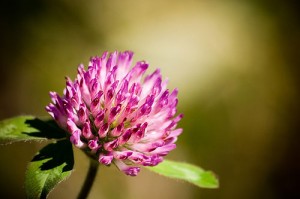By Sayward Rebhal,
Maybe you know of a berry bush in a nearby park. Maybe there’s a patch of clover around the corner. Once you’re onto it, it’s hard not to see tea almost everywhere.
Chamomile has always my favorite bedtime beverage. Growing up, we just bought the supermarket boxes of bagged tea. And although I enjoyed the pretty white flowers on the packaging, I never really considered the connection between the decorative exterior and the drink inside.
Flash forward a decade or so and I was working my way through college slinging coffee at a small art house. That’s where I discovered the joy of loose leaf teas. I remember the first time I opened the chamomile canister, and poured out a pile of … dried flowers! It seems silly now, but it was such a surprise to me. “Of course! Chamomile is a flower!”
Flash forward yet another decade, and these days I’m planting my own pretty white chamomile patch in my own little garden, harvesting and drying the buds, and brewing my own homegrown tea. And it is, unquestionably, the best tea I’ve ever tasted.
The great news is that chamomile is just the tip of the tea-stained iceberg. There are so many ways to collect your own herbal teas, whether you’re carefully cultivating a tea garden, or simply taking advantage while weeding your lawn. Maybe you know of a berry bush in a nearby park. Maybe there’s a patch of clover around the corner. Maybe you had a local carpenter build you a deck and you’re looking forward to relaxing there with a good cup of tea. Or you want to take a fresh cup of earthy herbal tea with you on your commute through New York City’s tile and concrete subway jungle. Once you’re onto it, it’s hard not to have fresh herbal tea almost everywhere. Here are my top six picks.
1. Chamomile
But of course! Use the whole flowers, fresh or dried. Chamomile is an age-old remedy for anxiety, upset stomach, and headaches. It’s also a sleep aide and a breastmilk booster.
2. Other Garden Flowers
There are tons of other flowers that can be dried and brewed just the same as chamomile. A few easy-to-grow options: Honeysuckle to reduce a fever; Lavender as a stress reliever and relaxant; Calendula for a super immune boost; and Borage as a natural antidepressant.
3. Dandelion
You can use the dried root or the dried leaves. Dandelion acts as a mild diuretic and a powerful detoxifier. It’s also a strengthening, nutritive brew.
4. Blackberry
The berries are a treat, but if you’ve ever had a blackberry bush spring up in your yard, you know what a scourge they can be. I’ve spent three summers trying to eradicate the thorny little devils from my garden, and they just keep coming back! Anyway, at least I’m getting something out of the deal. Blackberry leaves, fresh or dried, can help to purify the blood and to calm an inflamed kidney. They can also help to relieve diarrhea.
5. Red Clover
Use the dried flowers for overall wellness and purification. Red clover “cleans” the blood and balances the body, helps to regulate hormones, and is great for PMS!
6. Nettle
My favorite! I make nettle infusions daily, from the fresh leaves during spring and summer, and from the dried leaves during the fall and winter. This is a nutritive brew, so it’s good for strengthening and building. Nettles are very high in calcium, iron, and other important minerals.
Remember, these are just a sampling of the many, many plants that can be wildcrafted, foraged, or harvested, and turned into herbal teas. And don’t forget all the culinary herbs as well! Thyme, rosemary, basil, lemon balm, mint, and more – they’ll each add an interesting flavor, as well as a nourishing property, to your homemade brews.
Article Source – networx.com

If you've ever found value in our articles, we'd greatly appreciate your support by purchasing Mindful Meditation Techniques for Kids - A Practical Guide for Adults to Empower Kids with the Gift of Inner Peace and Resilience for Life.
In the spirit of mindfulness, we encourage you to choose the paperback version. Delve into its pages away from screen glare and notifications, allowing yourself to fully immerse in the transformative practices within. The physical book enriches the learning process and serves as a tangible commitment to mindfulness, easily shared among family and friends.
Over the past few years, Wake Up World has faced significant online censorship, impacting our financial ability to stay online. Instead of soliciting donations, we're exploring win-win solutions with our readers to remain financially viable. Moving into book publishing, we hope to secure ongoing funds to continue our mission. With over 8,500 articles published in the past 13 years, we are committed to keeping our content free and accessible to everyone, without resorting to a paywall.
Disclaimer: This article is not intended to provide medical advice, diagnosis or treatment. Views expressed here do not necessarily reflect those of Wake Up World or its staff.







